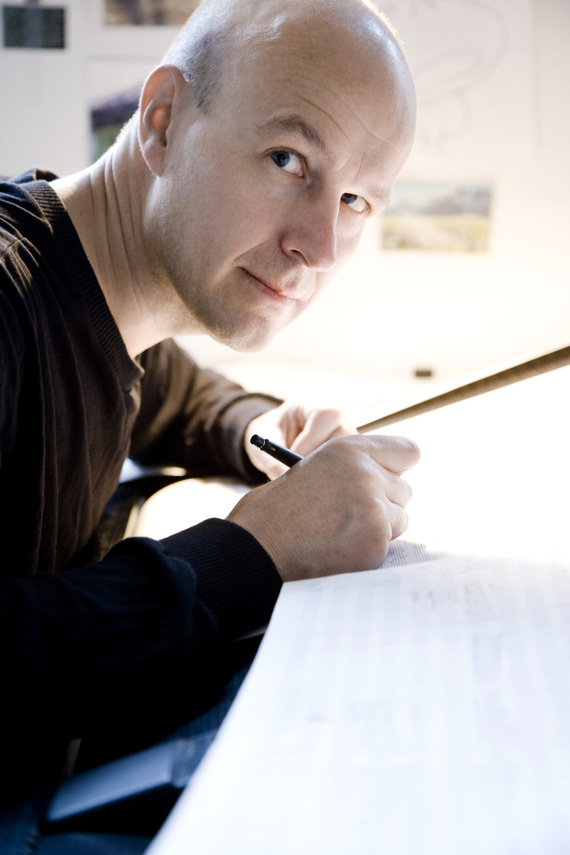Lightning strikes at Chamber Music Society’s modernist program

Thomas Larcher’s “Kraken” was performed by the Chamber Music Society of Lincoln Center Thursday night.
Accompanied by thunder and lightning, the stinging sound of freezing rain against the glass walls of the tenth floor Kaplan Penthouse, the Chamber Music Society of Lincoln Center was in its element with a concert of powerful new chamber music Thursday night. Notwithstanding the day’s treacherous weather, the venue was three-quarters full for the event.
The program of music from five different 20th- and 21st-century composers had no overriding theme, but was a reminder of both how chamber music has been at the core of innovation in composition since the Classical era, and how the challenges of writing music in which every part is exposed appeals to the finest composers. Among those in the last century of classical music was the titan, Elliott Carter, whose Quartet for Oboe, Violin, Viola and Cello opened the evening.
This 2001 piece is in what is generally considered Carter’s late style: the lines are quick and fluid, and there is a perpetual sense of change and invention. Unusual for his late works, which tend towards the aphoristic, the duration is around fifteen minutes.
The Quartet is a salient example of his astonishing craft, and of the integration of Carter’s composing with his aesthetic and social values. The four voices are in constant dialogue. He divides the ensemble into shifting pairs of lead and accompanying groups. Still, each instrument is essentially independent, reflecting Carter’s representation of democracy and eschewing of mechanical repetition.
The music is dense, complex, mercurial. Despite the independence, lines come together into counterpoint, perfect intervals and major and minor triads, antiphonal passages. The activity and dynamics ebb and flow. That synchronicity argues eloquently for Carter’s genius, as did the expert and lucid playing of oboist James Austin Smith, violinist Nicolas Dautricourt, violist Hsin-Yun Huang and cellist Nicholas Canellakis.
Another expert craftsman is Wolfgang Rihm. Violinist Sean Lee and pianist Gloria Chien played his Phantom und Eskapade for Violin and Cello, completed in the mid–1990s. The “Phantom” of the piece is the first part, a long, eloquent, minor key, meditation for the violin. The piano responds with both tonal and dissonant chords, and frequent, insistent repetition that intrudes on the violin line.
The “Eskapade” part is odd and intriguing, highly episodic, even manic. The music has a quaint quality: as it moves from action to romance to comedy, it sounds like the musical accompaniment to an imaginary Buster Keaton movie. That is no pejorative, certainly not in this skillful and committed performance, but the two parts do not quite make a logical and coherent whole.
The least convincing piece on this otherwise strong program was Leon Kirchner’s Trio No. 2 for Piano, Violin and Cello, now twenty years old. This was the one piece that, aesthetically, fell outside the values of modernism. The music is full of passionate intensity, “romanticismus” as Kirchner himself wrote. There are lots of big, soaring tunes for the cello—beautiful and intense playing from Dmitri Atapine—followed and pushed along by the other two instruments (Lee and Chien). The musical style and psychology combine Mahler’s racing moods with Strauss’ shifting phrases and more than a little existential angst.
The lightning came after intermission, as Dautricourt ripped into the virtuosic, intense solo opening of Thomas Larcher’s tremendous 1997 composition Kraken for Piano, Violin and Cello. The flashes in the sky paled in comparison to the brilliance of Larcher’s combination of structural simplicity and startlingly imaginative lines.
Laid across an almost-visible grid of measures that holds the piece together, the music explodes with freedom and variety. Answering the violin was a mesmerizing, almost mechanistic series of quarter notes that Chien played on the piano, the precision of rhythm and tempo conveying a surreal sense of control.
The music was joined in the third of five sections by Canellakis: the strings playing pianissimo over a clearly outlined pulse. Their phrase lengths are at odds, and off-kilter accents simulate a shifting sense of complex rhythms, while the piano adds short, punchy phrases on muted strings.
The result is a thrilling aural illusion greater than the sum of its parts, an example of craft that students will likely be studying for years to come. A spartan ballad follows, then the arch form of Kraken closes with the trio playing an emotionally tense variation of the opening violin solo, rounding off a superior performance.
Mario Davidovsky’s Quartetto No. 2 for Oboe, Violin, Viola and Cello concluded the concert, with the composer in attendance. This is a great piece of expressive modernism, moving easily between tonal and atonal passages that suit Davidovsky’s needs. It is mainly a solo for oboe, a demanding part that Smith played with confidence and expression.
The strings (here played by Lee, Huang and Atapine), don’t accompany the wind instrument so much as buffet it with sound. They answer, question, mock, condescend. There are moments when the oboe and the strings come together in cooperation, with sustained chords, mutual attacks and phrase lengths, before heading their separate but still conjoined ways. The oboe glides through through the music, often sounding wistful. The Chamber Music Society members delivered an altogether lovely and involving performance.
The Chamber Music Society performs music of Schubert and Mendelssohn 5 and 7:30 p.m. February 23. chambermusicsociety.org


